Generative AI automates tasks and innovates solutions, thereby revolutionizing many industries. However, with great power comes great responsibility. Ethical design and implementation of generative AI technologies depend on developers. They have to address issues like transparency, bias, and social impact.
Understanding and adhering to these responsibilities is essential to harness the full potential of generative AI while safeguarding ethical standards and public trust. This article will provide a detailed answer to the question: “What is the responsibility of developers using generative AI in ensuring ethical practices?”
>> Read more:
- Will AI Replace Software Engineers Altogether?
- Unlock Your Potential: Powerful ChatGPT Use Cases Explained
Bias Mitigation
Generative AI models learn from the data they are trained on. Unluckily, data can reflect the biases in the real world, causing the AI to produce outputs with those biases. This can have serious effects like generating discriminatory content and supporting negative preconceptions.
Solutions
Here's how developers can mitigate bias in generative AI:
- Data Cleansing: Evaluate training data strictly. Identify and remove biased data points (e.g., one race overrepresented in facial recognition training data).
- Fair Algorithms: Use techniques like data augmentation (generating diverse data) or designing fairness-focused models to reduce bias in machine learning systems.
- Bias Detection and Correction: Use both automated tools and human review to identify and fix bias in data or model outputs, then retrain the model with more balanced data.
Example
I propose that a generative AI model be trained on a dataset of news articles. If the dataset mostly consists of men's writings, the model could produce more content from a male viewpoint, causing gender bias in the AI's outputs. Using a data augmentation technique with more writers to diversity data can help developers lower this bias.
By proactively mitigating bias, developers can ensure that generative AI models are fair, inclusive, and representative of the real world.
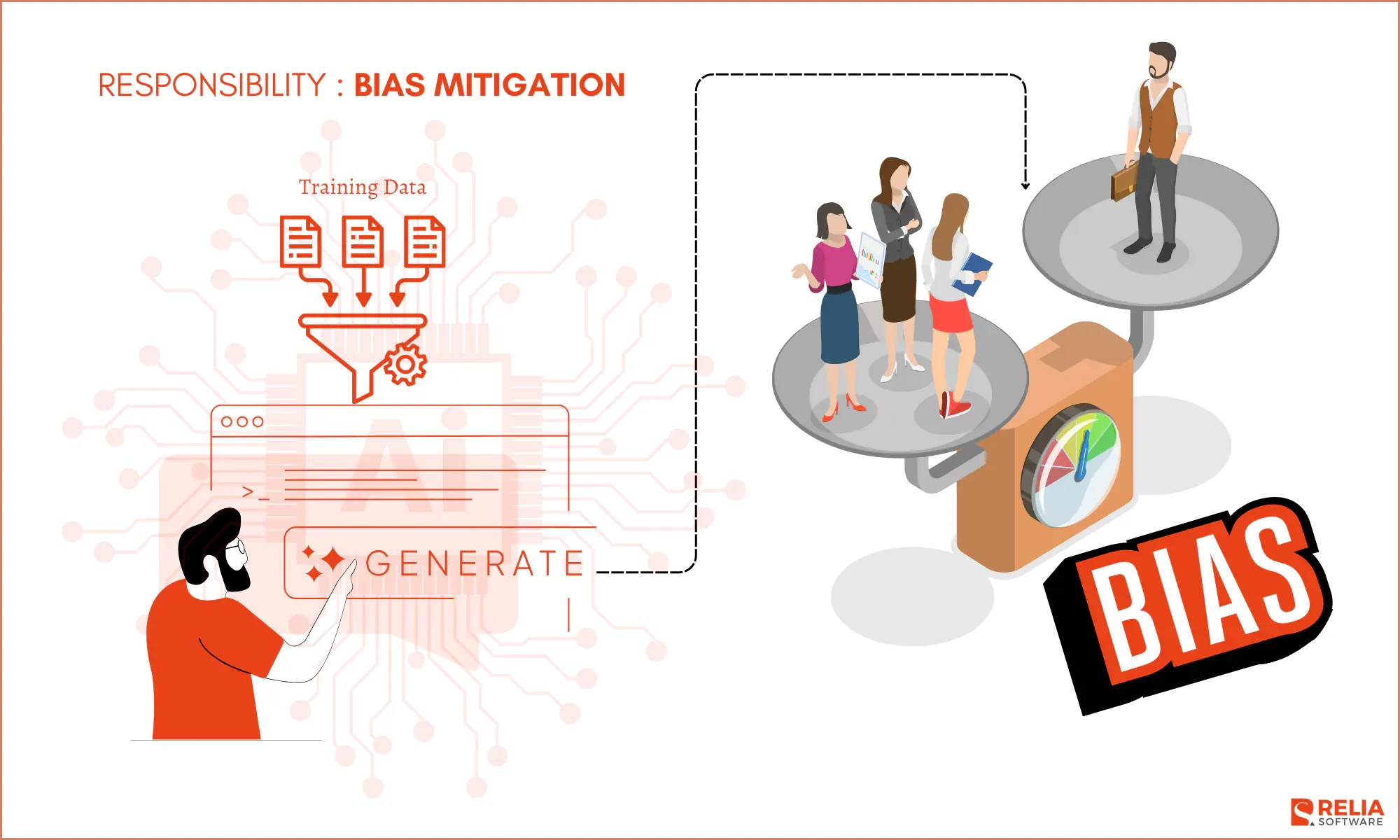
Transparency
The Black Box Problem
Generative AI models can be complex, often resembling a "black box" where the internal workings are difficult to understand. This lack of transparency makes it challenging to explain how the model arrives at its outputs, hindering trust and accountability.
Transparency is crucial for several reasons:
- Clarity for Users: To ensure accurate and trustworthy decisions in important domains like healthcare, users need clear insights into how AI draws its conclusions.
- Better Debugging: A transparent system helps developers find faults and improve model performance more easily.
- Fostering Trust: People are likely to trust and use AI systems more when they understand how AI models work and can check their reliability.
Solutions
These techniques help to gain transparency in generative AI:
- Explainable AI (XAI) Techniques: XAI method reveals the decision-making process of AI model. These methods range from simple feature attribution to more complex visualizations.
- Clear Documentation: Developers should clearly document the model's design, training data, and limits. Users can thus know what the model can and cannot do.
- User Control Mechanisms: Allowing users to control some aspects of the model's behavior (e.g., selecting parameters) can enhance transparency and trust.
Example
Consider an AI model used for loan approvals. Fair and unbiased AI decisions really need transparency. Developers can do this by using explainable AI (XAI), providing clear documentation, and allowing users to adjust settings. This approach helps create AI models that are effective, ethical, and trusted by users.
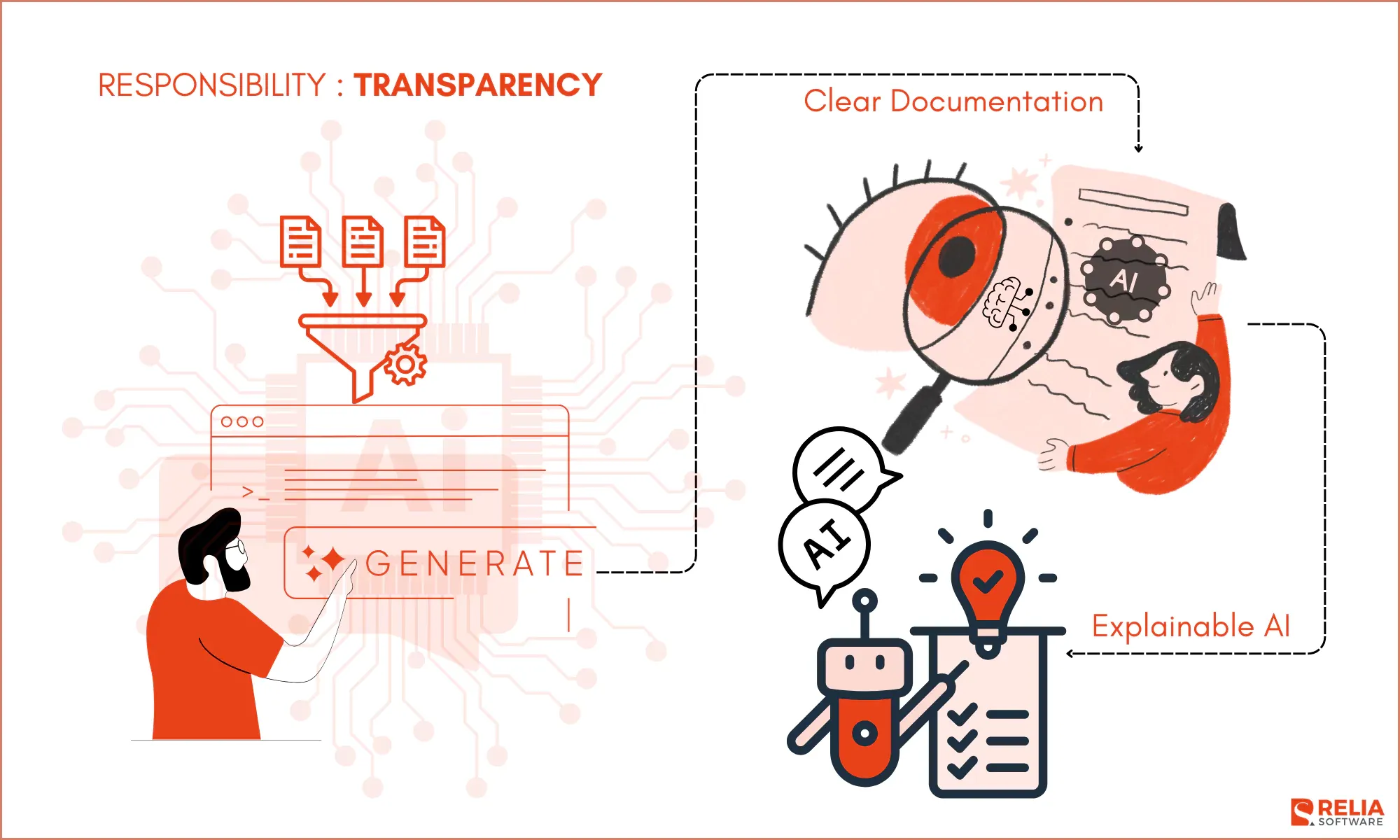
>> Read more about AI in software development:
- Benefits of Artificial Intelligence (AI) in Mobile App Development
- AI in Software Testing: How It Works, Benefits & Challenges
- Top 10 Best AI Development Tools for Software Developers
- How Does No-Code AI Assist In App Development?
User Privacy and Data Security
Generative AI mostly depends on data, so protecting user privacy and data security is really vital. Let's break down these aspects here.
Protecting User Privacy
Generative AI systems can provide outputs including personal data or depend on user data for training. Developers have to guarantee user privacy via some steps:
- Data Minimization: Only collect and use the data that the generative AI model really need to function.
- Data Anonymization: Anonymize user data whenever possible before feeding it to the model. This reduces the risk of spotting individuals from the output.
- User Consent and Control: Get clear user permission for gathering and using data. Give users also control over their data so they may choose to opt-off or request a deletion.
Security Concerns and Safeguards
Generative AI systems are prone to security breaches like other software. You know, malicious actors could exploit vulnerabilities to access sensitive data or change model outputs. Here's how developers can boost security:
- Secure Data Storage and Access Controls: Implement robust security measures to protect user data from unauthorized access, including encryption, secure storage protocols, and access control mechanisms.
- Model Monitoring: Monitor the generative AI model for strange behavior that may signal a security breach or manipulation attempt.
- Regular Security Audits: Do regular security audits to identify and fix potential vulnerabilities in the system.
Real-World Example
Protecting User Privacy in AI-Generated Chatbots
Imagine a generative AI model used to create chatbots for customer service applications. Customer identities and purchase histories may be used to train these chatbots. For user privacy, developers should:
- Anonymize the training data: Use unique identifiers instead of real names.
- Limit data collection: Only collect the data necessary for the chatbot to function effectively, such as keywords and general customer inquiries.
- Allow users to opt out: Users can say yes or no to their data used for chatbot training.
By addressing privacy and security, developers may create generative AI systems ethical and reliable. This builds trust and permits effective use of this strong technology.
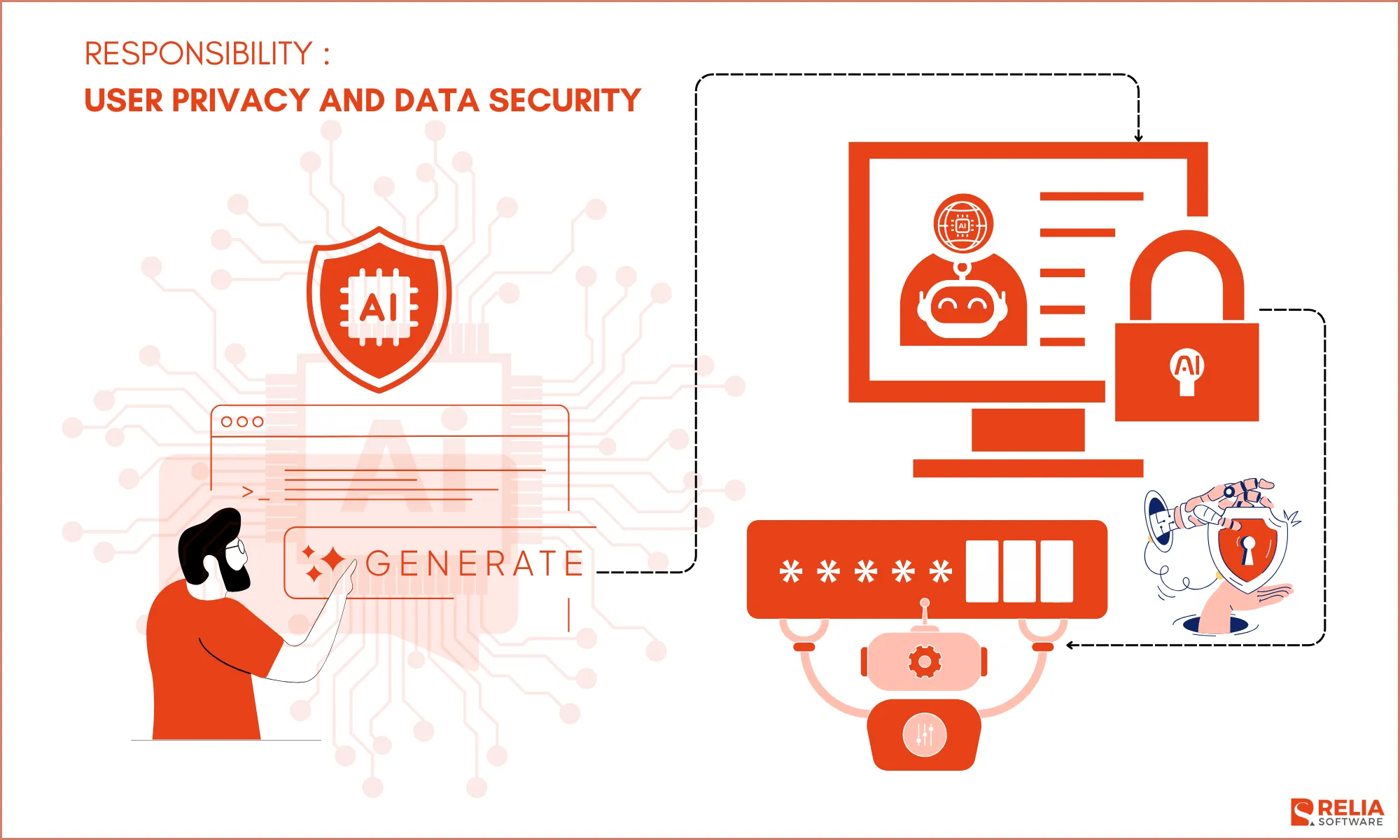
Control and Accountability
Developers using generative AI must ensure user control and accountability over their AI systems. They must let users control AI outputs and create systems to make the technology answerable for its actions. These are necessary for ethics and user trust.
User Control
- User Customization: Provide options for users to customize the AI’s outputs according to their preferences. This can include setting parameters, selecting output types, or adjusting the AI’s behavior.
- Feedback Mechanisms: Implement systems where users can provide feedback on AI outputs. This helps improve the model to meet user expectations.
- Transparency in Functionality: Users can understand and make suitable improvements when understanding how the AI operates and what factors affect its outputs.
Accountability Mechanisms
- Clear Documentation: Document the AI model's design, data sources, and decision-making.
- Regular Audits: Frequent audits help to evaluate the AI’s performance, spot biases, and guarantee ethical norms' compliance.
- Error Reporting and Correction: Establish procedures for reporting errors or unintended consequences, with swift corrective actions.
Real-World Example
Consider an AI model used for content moderation on social media platforms. To ensure control and accountability, developers can:
- User Customization: Let users report improper content and customize their content preferences.
- Feedback Mechanisms: Enable users to provide feedback on moderation decisions, which can be used to improve the model.
- Transparent Functionality: Explain what content is flagged and how the moderation decisions are made.
- Regular Audits: Conduct independent audits to ensure the AI’s decisions align with community standards and ethical guidelines.
- Error Reporting: Provide a clear process for users to report errors, with a team dedicated to reviewing and addressing these reports.
Developers may build trustworthy, ethical, and effective AI systems by stressing user control and accountability.

Creating AI Policies
Creating effective AI policies is essential for guiding the ethical development and deployment of AI systems.
Define Objectives and Principles
- Ethical Standards: Establish clear ethical guidelines that the AI system must adhere to, covering fairness, transparency, and user privacy.
- Compliance: Policies should match relevant laws and regulations, especially those related to data protection and non-discrimination.
Policy Components
- Data Handling: Outline how data will be collected, stored, and used, emphasizing data minimization and user consent.
- Bias Mitigation: Implement strategies to identify and reduce biases in AI models, such as diverse training data and fairness audits.
- Accountability: Define roles and duties for tracking AI performance and handling any problems that arise.
Implementation and Monitoring
- Training and Awareness: Educate team members on AI policies and ethical practices.
- Continuous Review: Regularly update policies to reflect new insights, technologies, and regulatory changes.
- User Feedback: Use user feedback to hone and improve AI models.
Example
Think about an AI model for medical diagnosis. AI policies should ensure:
- Patient Privacy: Protect patient information and follow healthcare rules to keep patient privacy.
- Accuracy and Fairness: Regularly test and validate the model to avoid biases and ensure accurate diagnoses.
- Transparency: Show patients and healthcare professionals exactly how the AI system operates and its restrictions.
By creating comprehensive AI policies, developers can ensure their AI systems operate ethically, comply with regulations, and maintain user trust.
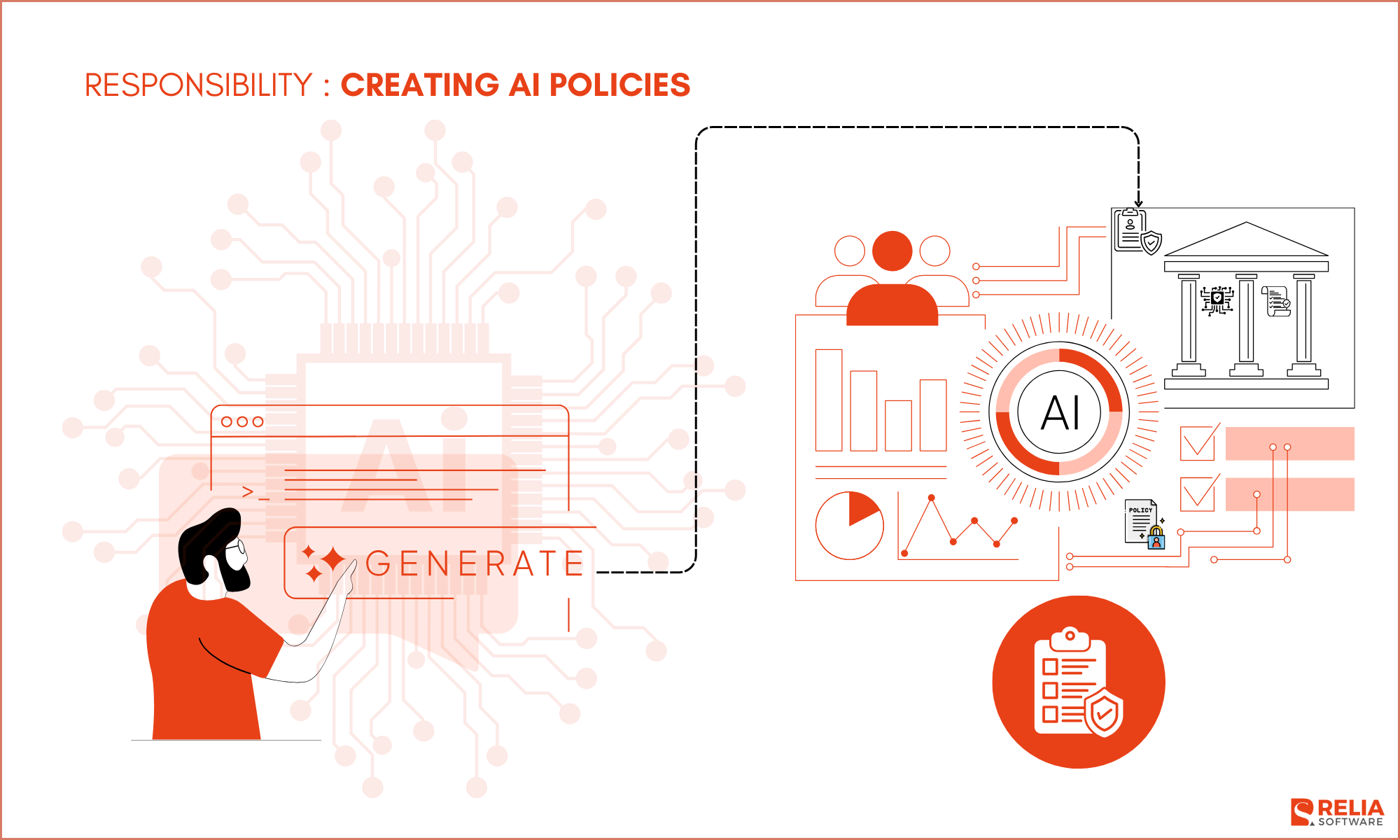
Societal Impact Considerations
Generative AI has far-reaching societal impacts, and developers have a responsibility to consider these effects:
- Job Displacement: Automation by generative AI could lead to job losses in certain sectors, particularly those involving repetitive tasks.
- Disinformation and Bias: Generative AI can be misused to create deepfakes or biased content, thereby false information is spread and shaping public opinion unfairly.
- Algorithmic Bias: If training data is biased, AI systems may reinforce those biases, leading to unfair treatment and inequality.
Solutions
Here are some ways to reduce harmful effects:
- Transparency and Explainability: Giving transparency a priority in AI development is the primary way for developers to foster public trust and understanding. This allows for open conversations about potential risks and encourages collaboration on ethical solutions.
- Human-Centered Design: Human needs and well-being should guide generative AI development. Developers should focus on how technology can assist rather than replace humans, creating more generative AI opportunities that support people instead of sidelining them. Thus, new job opportunities will be created alongside automation.
- Collaboration with Social Scientists and Ethicists: Developers should work with social scientists and ethicists to detect social dangers better and provide fair and socially beneficial solutions.
Example
Imagine developing an AI that can generate news articles. Here's how to consider societal impact:
- Fact-Checking and Bias Detection: Use strong fact-checking systems and bias detection tools to guarantee produced news articles are objective and accurate.
- Human Oversight and Editorial Control: Maintain a human editorial team to review AI-generated content for factual accuracy, potential bias, and adherence to journalistic ethics.
- Transparency about AI Authorship: Clearly indicate when an article is partially or fully generated by AI. This fosters transparency and allows readers to make informed judgments about the information they consume.
Developers can guarantee generative AI becomes a tool for good by proactively addressing potential societal impacts. This promotes responsible innovation that benefits society as a whole.
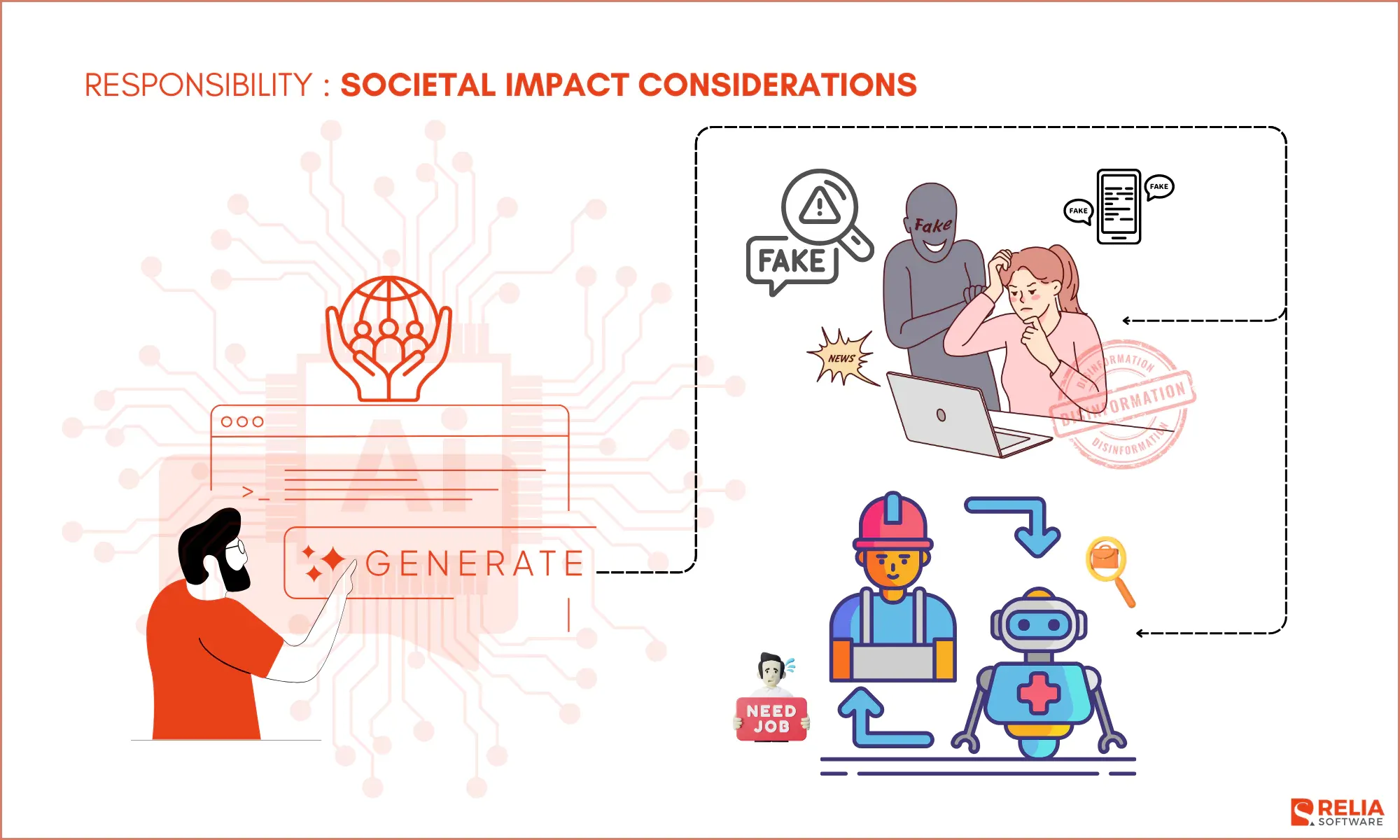
>> You may consider:
- Top 7 Machine Learning Solutions For Growing Your Business
- Top 9 Machine Learning Platforms for Developers
- Top 9 Best Deep Learning Frameworks for Developers
- What is Agentic AI? Workflows, Use Cases, Benefits & More
Final Thoughts
Generative AI could transform many things with its groundbreaking technology. However, developers must use this transformative potential ethically and responsibly. We can build socially beneficial AI systems by reducing biases, assuring transparency, protecting privacy, and establishing accountability.
Developing and using generative AI requires continual learning and collaboration with specialists in other fields like society, ethics, and politics, etc. not to violate ethical standards. Overall, AI is helpful but needs the responsibility of developers using generative AI to ensure ethical practices.
>>> Follow and Contact Relia Software for more information!
- development
- Mobile App Development
- Web application Development

